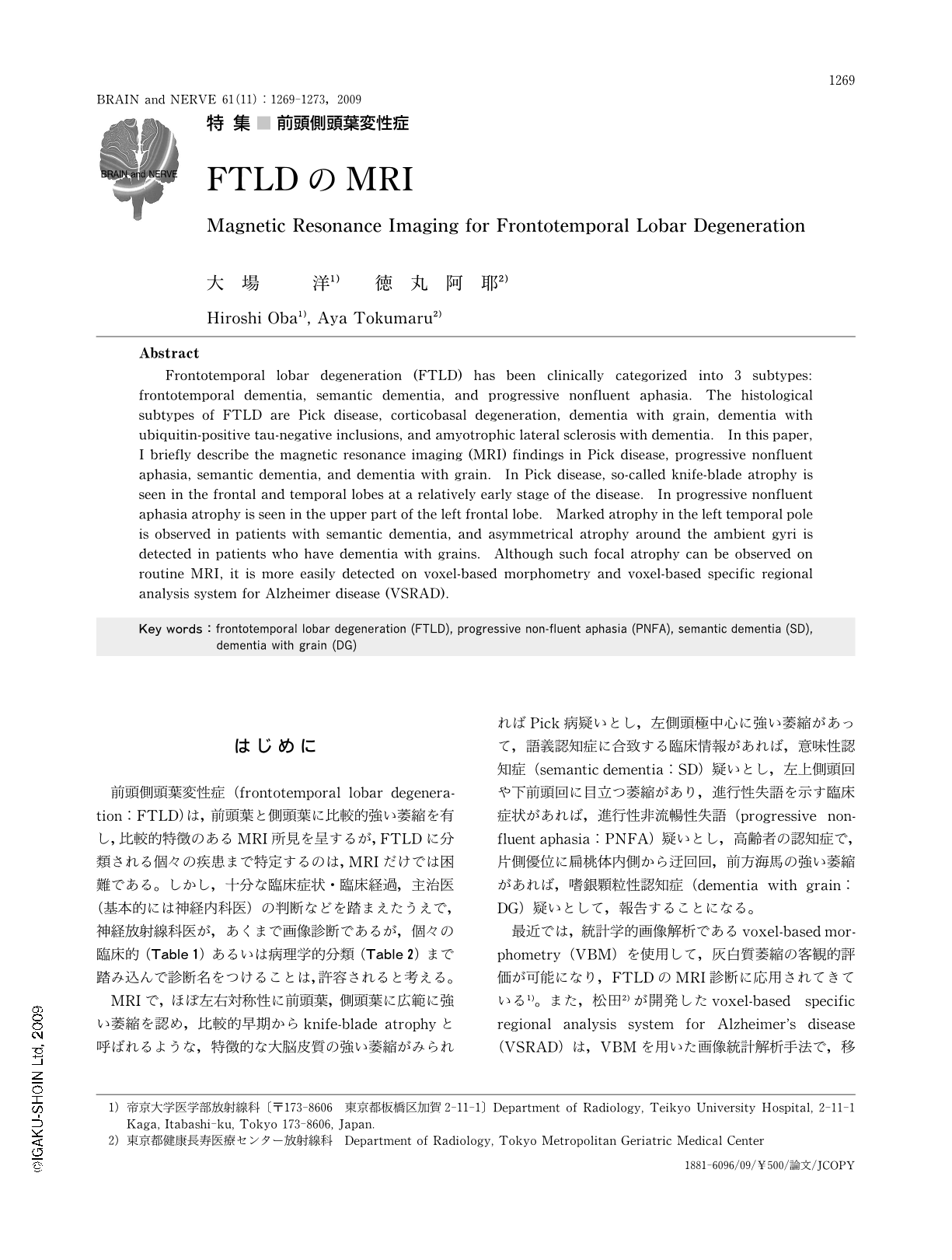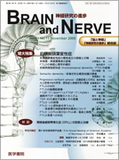Japanese
English
- 有料閲覧
- Abstract 文献概要
- 1ページ目 Look Inside
- 参考文献 Reference
はじめに
前頭側頭葉変性症(frontotemporal lobar degeneration:FTLD)は,前頭葉と側頭葉に比較的強い萎縮を有し,比較的特徴のあるMRI所見を呈するが,FTLDに分類される個々の疾患まで特定するのは,MRIだけでは困難である。しかし,十分な臨床症状・臨床経過,主治医(基本的には神経内科医)の判断などを踏まえたうえで,神経放射線科医が,あくまで画像診断であるが,個々の臨床的(Table1)あるいは病理学的分類(Table2)まで踏み込んで診断名をつけることは,許容されると考える。
MRIで,ほぼ左右対称性に前頭葉,側頭葉に広範に強い萎縮を認め,比較的早期からknife-blade atrophyと呼ばれるような,特徴的な大脳皮質の強い萎縮がみられればPick病疑いとし,左側頭極中心に強い萎縮があって,語義認知症に合致する臨床情報があれば,意味性認知症(semantic dementia:SD)疑いとし,左上側頭回や下前頭回に目立つ萎縮があり,進行性失語を示す臨床症状があれば,進行性非流暢性失語(progressive nonfluent aphasia:PNFA)疑いとし,高齢者の認知症で,片側優位に扁桃体内側からう回回,前方海馬の強い萎縮があれば,嗜銀顆粒性認知症(dementia with grain:DG)疑いとして,報告することになる。
最近では,統計学的画像解析であるvoxel-based morphometry(VBM)を使用して,灰白質萎縮の客観的評価が可能になり,FTLDのMRI診断に応用されてきている1)。また,松田2)が開発したvoxel-based specific regional analysis system for Alzheimer's disease(VSRAD)は,VBMを用いた画像統計解析手法で,移行嗅内野皮質を関心領域として,Alzheimer病診断のための非常に簡便で有用なソフトウェアであるが,FTLDの診断にも役に立つ。FTLDの1つ,認知症を伴う筋萎縮性側索硬化症(amyotrophic lateral sclerosis with dementia:ALS-D),三山型ALSについては,別稿に譲る。
Abstract
Frontotemporal lobar degeneration (FTLD) has been clinically categorized into 3 subtypes: frontotemporal dementia,semantic dementia,and progressive nonfluent aphasia. The histological subtypes of FTLD are Pick disease,corticobasal degeneration,dementia with grain,dementia with ubiquitin-positive tau-negative inclusions,and amyotrophic lateral sclerosis with dementia. In this paper,I briefly describe the magnetic resonance imaging (MRI) findings in Pick disease,progressive nonfluent aphasia,semantic dementia,and dementia with grain. In Pick disease,so-called knife-blade atrophy is seen in the frontal and temporal lobes at a relatively early stage of the disease. In progressive nonfluent aphasia atrophy is seen in the upper part of the left frontal lobe. Marked atrophy in the left temporal pole is observed in patients with semantic dementia,and asymmetrical atrophy around the ambient gyri is detected in patients who have dementia with grains. Although such focal atrophy can be observed on routine MRI,it is more easily detected on voxel-based morphometry and voxel-based specific regional analysis system for Alzheimer disease (VSRAD).

Copyright © 2009, Igaku-Shoin Ltd. All rights reserved.


